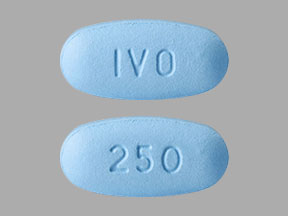Tibsovo Dosage
Generic name: ivosidenib 250mg
Dosage form: tablet, film coated
Drug class: Miscellaneous antineoplastics
Medically reviewed by Drugs.com. Last updated on Oct 30, 2023.
Patient Selection
Select patients for treatment with TIBSOVO based on the presence of IDH1 mutations [see Clinical Studies (14.1, 14.2, 14.3, 14.4)].
Information on FDA-approved tests for the detection of IDH1 mutations in AML, MDS, and cholangiocarcinoma is available at http://www.fda.gov/CompanionDiagnostics.
Recommended Dosage
The recommended dosage of TIBSOVO is 500 mg taken orally once daily until disease progression or unacceptable toxicity [see Clinical Studies (14.1, 14.2, 14.3, 14.4)].
For patients with AML or MDS without disease progression or unacceptable toxicity, continue TIBSOVO for a minimum of 6 months to allow time for clinical response.
- Administer TIBSOVO with or without food.
- Do not administer TIBSOVO with a high-fat meal [see Warnings and Precautions (5.2) and Clinical Pharmacology (12.3)].
- Do not split, crush, or chew TIBSOVO tablets.
- Administer TIBSOVO tablets orally about the same time each day.
- If a dose of TIBSOVO is vomited, do not administer a replacement dose; wait until the next scheduled dose is due.
- If a dose of TIBSOVO is missed or not taken at the usual time, administer the dose as soon as possible and at least 12 hours prior to the next scheduled dose. Return to the normal schedule the following day. Do not administer 2 doses within 12 hours.
Newly Diagnosed AML (Combination Regimen)
Start TIBSOVO administration on Cycle 1 Day 1 in combination with azacitidine 75 mg/m2 subcutaneously or intravenously once daily on Days 1-7 (or Days 1-5 and 8-9) of each 28-day cycle [see Clinical Studies (14.1)]. Refer to the Prescribing Information for azacitidine for additional dosing information.
Monitoring and Dosage Modifications for Toxicities
Obtain an electrocardiogram (ECG) prior to treatment initiation. Monitor ECGs at least once weekly for the first 3 weeks of therapy and then at least once monthly for the duration of therapy [see Warnings and Precautions (5.2)]. Manage any abnormalities promptly.
Interrupt dosing or reduce dose for toxicities. See Table 1 for dosage modification guidelines.
| Adverse Reactions | Recommended Action |
|---|---|
|
|
|
|
|
|
|
|
|
|
|
|
|
|
|
As monotherapy in AML and MDS:
|
Patients with AML or MDS
Assess blood counts and blood chemistries prior to the initiation of TIBSOVO, at least once weekly for the first month, once every other week for the second month, and once monthly for the duration of therapy.
Monitor blood creatine phosphokinase weekly for the first month of therapy.
Dosage Modification for Use with Strong CYP3A4 Inhibitors
If a strong CYP3A4 inhibitor must be coadministered, reduce the TIBSOVO dose to 250 mg once daily. If the strong inhibitor is discontinued, increase the TIBSOVO dose (after at least 5 half-lives of the strong CYP3A4 inhibitor) to the recommended dose of 500 mg once daily.
Frequently asked questions
More about Tibsovo (ivosidenib)
- Check interactions
- Compare alternatives
- Pricing & coupons
- Drug images
- Side effects
- During pregnancy
- FDA approval history
- Drug class: miscellaneous antineoplastics
- Breastfeeding
- En español
Patient resources
Professional resources
Related treatment guides
Further information
Always consult your healthcare provider to ensure the information displayed on this page applies to your personal circumstances.

